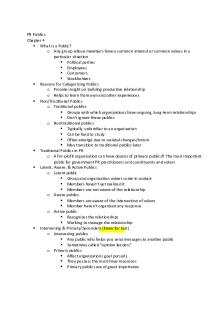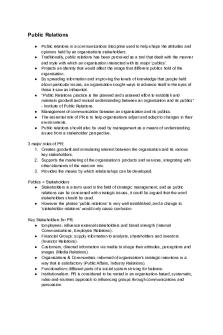Public Relations week 1 notes PDF

| Title | Public Relations week 1 notes |
|---|---|
| Course | Sales and Customer Relations |
| Institution | University of Massachusetts Lowell |
| Pages | 3 |
| File Size | 58.4 KB |
| File Type | |
| Total Downloads | 83 |
| Total Views | 151 |
Summary
Public Relations notes, study guide, and answers...
Description
Public Relations week 1 notes Definitions of Public Relations: The actions of a corporation, store, government, individual, etc., in promoting goodwill between itself and the public, the community, employees and customers. The art, technique or profession of promoting such goodwill. RACE Process: o Phineas T. Barnum: Pseudo-event—a planned happening that occurs primarily for the purposes of being reported o Purposely gave his circus stars short names so their names could fit into the narrow headings of newspapers o Made up anything to attract attention to his circus and museum Rise in Politics - Amos Kendall: considered the first presidential press secretary (Andrew Jackson) Ivy Ledbetter Lee - Ludlow Massacre and Rockefeller: Rockefeller family owned 40% 10-day strike led to 53 deaths in 1914 Lee advised Rockefellers and coal industry o Assessed public opinion Created informational bulletins and press events Edward Bernays—campaigns: father of modern PR, nephew of Freud, used psychology in his ads, made the ivory soap advertise, and big for making cigarettes seems cool but it was to make women also seem cool Steps in the PR process in action: o Step 1: Research - Define the public relations problem o Step 2: Planning o Step 3: Implementation (taking action) o Step 4: Evaluation How PR differs from Journalism: Journalists Use only two components (writing and media relations) o Are objective observers o Focus on a mass audience o Use only one channel PR Professionals o Use many components o Are advocates o Focus on defined publics o Use a variety of channels How PR differs from advertising: Advertising Works through mass media outlets Addresses external audiences o Is a communications function o Is a communication tool in PR Sells goods and services
Relies on a variety of communication tools o Targets specialized audiences Is broader in scope Fills a support role Creates a favorable environment for an organization's survival How PR differs from marketing: Marketing Is concerned with customers and selling products or services Deals with target market, consumers, and customers o Is concerned with building relationships and generating goodwill Deals with publics, audiences, and stakeholders Controlled Media: the ability that media is no controlled since social media,but being able to manage what is said by a company Media Relations: involves working with media for the purpose of informing the public of an organization's mission, policies and practices in a positive, consistent and credible manner. Typically, this means coordinating directly with the people responsible for producing the news and features in the mass media. The goal of media relations is to maximize positive coverage in the mass media without paying for it directly through advertising. Six essential abilities in PR: Writing skills o Research ability o Planning expertise o Problem-solving ability o Business/economics competence o Expertise in social media Cultural Literacy: how well someone can communicate in a given culture Ancient beginnings—Egypt, Julius Caesar, and propaganda: The Rosetta Stone—touting the pharaoh's accomplishments Julius Caesar—acta diurna ("daily doings") became first newspapers Pope Gregory XV—established the first College of Propaganda PR in colonial America—conflict positioning: Promoting settlement o Struggle for independence Boston Tea Party—"greatest publicity stunt of all time" Thomas Paine—"Common Sense" sold more than 120,000 copies Federalist Papers—85 letters by Alexander Hamilton, James Madison and John Jay o Age of the press agent: The age of hype, glorifying frontier heroes and "rock stars" of their era o Davy Crockett, Buffalo Bill, Annie Oakley o Press agent tactics with exaggerations and even lies Corporate Social Responsibility: corporations desire to be seen as having a caring image on society PRSA: Public Relations Society of America largest PR networking agency in the world
Compulsory-advisory position: organization policy requires that line managers(top management)at least listen to the appropriate staff experts before deciding on a strategy Primary and Secondary Research: primary - finding new information secondary - using old information Message Testing: using groups to see how a message goes with certain types of individuals o Measurement: to see how well an advertisement does Research Techniques: quantitative and qualitative interviews focus group Qualitative and Quantitative Research: qualitative - is facts and word of moth quantitative - is numbers Content Analysis: is a technique for systematically describing written, spoken or visual communication. It provides a quantitative (numerical) description. Many content analyses involve media - print (newspapers, magazines), television, video, movies, the Internet....
Similar Free PDFs

Public Relations week 1 notes
- 3 Pages

Public relations
- 60 Pages

Public relations
- 15 Pages

Public Relations
- 24 Pages

Kampanye Public Relations
- 154 Pages

Chapter 4 - Public Relations
- 3 Pages

Sports public relations
- 3 Pages

AMB263 Public Relations A1
- 4 Pages

Public relations theory
- 11 Pages

Professional Public Relations
- 199 Pages

Mastering Public Relations
- 188 Pages

Public Relations - Syllabus
- 5 Pages

Public Relations Assignment
- 3 Pages

DIGITAL PUBLIC RELATIONS
- 10 Pages

Public Relations Theories-ppt
- 26 Pages
Popular Institutions
- Tinajero National High School - Annex
- Politeknik Caltex Riau
- Yokohama City University
- SGT University
- University of Al-Qadisiyah
- Divine Word College of Vigan
- Techniek College Rotterdam
- Universidade de Santiago
- Universiti Teknologi MARA Cawangan Johor Kampus Pasir Gudang
- Poltekkes Kemenkes Yogyakarta
- Baguio City National High School
- Colegio san marcos
- preparatoria uno
- Centro de Bachillerato Tecnológico Industrial y de Servicios No. 107
- Dalian Maritime University
- Quang Trung Secondary School
- Colegio Tecnológico en Informática
- Corporación Regional de Educación Superior
- Grupo CEDVA
- Dar Al Uloom University
- Centro de Estudios Preuniversitarios de la Universidad Nacional de Ingeniería
- 上智大学
- Aakash International School, Nuna Majara
- San Felipe Neri Catholic School
- Kang Chiao International School - New Taipei City
- Misamis Occidental National High School
- Institución Educativa Escuela Normal Juan Ladrilleros
- Kolehiyo ng Pantukan
- Batanes State College
- Instituto Continental
- Sekolah Menengah Kejuruan Kesehatan Kaltara (Tarakan)
- Colegio de La Inmaculada Concepcion - Cebu
